Abstract
Objectives:
To assess the prevalence of vaccine hesitancy and its determinants among Saudi parents. In addition, we explored the relationship between vaccine hesitancy and child’s immunization status.
Methods:
A cross-sectional study was conducted using interviews with parents visiting outpatient clinics at King Khalid University Hospital, Riyadh, Kingdom of Saudi Arabia, between July 2017 and October 2018. The strategic advisory group of experts on immunization vaccine hesitancy survey was used.
Results:
A total of 500 parents were interviewed. Twenty percent of parents were hesitant to get their child vaccinated. Parents with higher educational levels were more vaccine hesitant (p<0.001). Among parents who reported hesitancy toward vaccination, 36% of children were not vaccinated fully for their age. Concerns related to vaccine safety were the most frequent reason (53%) reported by vaccine-hesitant parents. Negative beliefs toward vaccination seemed to be associated with increase hesitancy and incomplete vaccination status of children. In multivariate analyses, the main factors associated with both parents’ hesitancy and incomplete vaccination status were believing that vaccines are ineffective (adjusted odds ratio [AOR]=28, 95% confidence interval [CI]: 7.9-102.3) and believing that vaccines are not important (AOR=27, 95%CI: 5.8-126).
Conclusion:
Vaccine hesitancy among parents in Kingdom of Saudi Arabia is a concern and is likely to influence the vaccination status of their children. Countering vaccine related concerns must be tailored, particularly in higher-educated groups.
Vaccination is one of the most effective and safest public health interventions. Despite the global success of vaccines, a vaccine confidence gap is emerging in all high, middle, and low income countries.1,2
Vaccination programs depend on a high uptake level to achieve successful reduction in the prevalence and incidence of vaccine-preventable diseases (VPDs). Infections such as polio, tetanus, diphtheria, measles, mumps, and rubella are now uncommon in developed countries. Consequently, with the close elimination of these infections, they no longer serve as a reminder of the benefit of vaccines.3 Instead, public attention has been diverted to the risk of vaccines and their related adverse events. During the last few years, controversies over vaccines and autism, vaccine ingredients, and the number of shots administered during a single clinic visit or during the first years of life have been some of the topics provoking concern from parents, policy makers, and the media toward the safety of recommended immunizations.4-6 The speedy evolution of the internet and social media has made it easier to publicize and circulate misleading information on vaccines from non-medical sources. Refusal of vaccines not only increases the individual risk to diseases but can profoundly threaten the whole community. Recent outbreaks of VPDs, including measles and pertussis, many of which were fueled by vaccine refusal, have provoked attention on how vaccine hesitancy can negatively affect public health.7,8 Vaccine hesitancy is recognized by the World Health Organization (WHO) as a mounting concern worldwide, affecting high, middle, and limited resource settings and was listed as one of WHO’s top 10 health threats of 2019.9 The WHO Strategic Advisory Group of Experts on Immunization (SAGE) working group defines vaccine hesitancy as “a delay in acceptance or refusal of vaccines despite availability of vaccination services.” This group rightly noted that vaccine hesitancy is complex and context specific, varying across vaccines, place, and time. Factors contributing to vaccine hesitancy included lack of confidence (namely, not trusting vaccines or health care providers), complacency (for example, vaccination is not considered essential), and convenience (namely, accessibility and affordability).10
Vaccine-hesitant parents (VHPs) comprise a much broader group than those who completely refuse vaccines and are thus potentially more acceptable to behavior changes since they tend to pursue information from their child’s health care provider about vaccines.11 With such a heterogeneous group, vaccine hesitancy can be difficult to measure. Larson et al,12 from the SAGE developed a vaccine hesitancy measurement tool in 2015. This tool is proposed to quantify vaccine hesitancy through the use of a vaccine hesitancy scale.12 Such standardized tools of vaccine hesitancy beliefs can provide support to the development of research and vaccination policy.
In Kingdom of Saudi Arabia (KSA), the expanded program on immunization was started in 1979 and originally contained vaccines for diphtheria, tetanus, and pertussis (DTP), poliomyelitis, tuberculosis and was subsequently expanded to include other additional vaccines.13 At that time, the legislation supported the practice of linking the issue of birth certificates to completion of primary immunizations during the first 2 years of life. This practice was changed 10 years ago to link the vaccination card with school entry at 6 years of age. The National Immunization Program has achieved eradication of neonatal tetanus and polio. Measles, mumps, and rubella (MMR) are targeted for elimination by 2020.14 According to the immunization coverage data published by the Saudi Ministry of Health in 2017, the coverage rates for MMR is 96% and DTP is 98%.15 However, the reported high immunization coverage rates do not imply high confidence in vaccines. In some countries, the legal prerequisites of a complete vaccination card for a child’s admittance to school are probably influencing many parents’ decisions to immunize their children. Furthermore, even parents who get their children vaccinated still have misinformation and worries related to vaccines; therefore, interventions targeted at changing their perception will reduce their level of hesitancy.16
The extent of vaccine hesitancy had not been formally assessed in KSA. Therefore, this study was undertaken to assess the prevalence of vaccine hesitancy among Saudi parents along with its determinants. In addition, we sought to explore the relationship between vaccine hesitancy (using the vaccine hesitancy scale) and child’s immunization status (partial/complete) in Riyadh, KSA.
Methods
A cross-sectional interview of 500 parents of children aged 2 months to 7 years who were attending the Pediatric Outpatient Clinic at King Khalid University Hospital, Riyadh, KSA, was conducted between July 2017 and October 2018.
Parents who had more than one child between 2 months and 7 years of age were requested to answer the questions about their youngest child only. The research proposal was approved by the Institutional Review Board of College of Medicine, King Saud University in Riyadh, KSA.
Study population
Identification of targeted parents was accomplished by inspecting the outpatient pediatric clinic booking list provided by the nursing staff of the clinic to the research investigators to facilitate the approaching process. Non-Saudi parents and parent of children with an immunodeficiency that necessitated exclusion of some vaccines were excluded. Purposeful sampling was performed based on subjects eligibility criteria. The investigators approached parents during their visit to the clinic. Parents who are eligible for recruitment were enrolled immediately after obtaining their verbal consent. Participation was voluntary, and no incentives were used. Interviews lasted on average 10-12 minutes.
Sample size calculation was dependent on expected level of parental vaccine hesitancy in KSA. However, due to lack of studies estimating parental vaccine hesitancy in KSA and because of variability of hesitancy between different countries as a result of variation in hesitancy definition, a conservative hesitancy prevalence of 20% was presumed where a sample of 488 subjects was estimated using the formula for a prevalence assessment, n=([z2×p×q])/d2, where z= 99% CI, p= 20% prevalence of hesitancy, q= 1-p, d= error ≤5% and a 15% non-response rate.
Data collection method
Data were collected using a questionnaire using the 11-item vaccine hesitancy scale, designed by the SAGE group.12 Data collection occurred between July 2017 and October 2018.
Parents completed 10 dichotomous (yes/no) questions, 11 Likert-type scale (strongly agree, agree, neutral, disagree, or strongly disagree) vaccine hesitancy scale questions, and 5 open-ended questions. Vaccination status was evaluated based on the immunization status of the youngest child under the care of the parent: fully vaccinated, unvaccinated, or partially vaccinated for age. To maintain the original tool, no modifications were made. All questionnaires were filled via interviewers. One pediatric resident and 3 final-year medical students performed all interviews with parents. Training of data collectors was performed in one introductory session, followed by a piloting stage of 20 participants and then a final evaluation and recommendation session. Interviews were performed in the pediatric clinic in a secure and private setting.
Data analysis and statistical tests
Statistical analysis was performed using the Statistical Package for the Social Sciences version 21 (IBM Corp., Armonk, NY, USA). Frequencies and proportions were used to summarize categorical variables. Means and standard deviations were used to summarize continuous variables. A coding system was used to facilitate entry of closed-ended question. Comparisons of the answers to the 11-item likert-type scale between fully immunized and partially immunized children were performed using Chi-square test. However, the majority of participants responses were higher in the strongly agree or strongly disagree categories resulting in low numbers or multiple empty spaces within agree, neutral or disagree categories. To enhance the study’s power to detect difference between study groups, grouping of Lickert scale items was performed where items strongly agree and agree were labeled as agree and items neutral, disagree or strongly disagree were labeled as did not agree. To explore which attitude items predicted parents’ vaccine hesitancy and partial immunization status of the child, multivariate logistic regression was performed, adjusting for the parents’ sociodemographic characteristics (age, gender, education level, number of children under care of respondents, and age of youngest child under care of respondents).
Results
A total of 500 parents were interviewed. Respondents’ sociodemographic characteristics are presented in Table 1. Most parents surveyed were female (90.8%) and reported an educational completion of bachelor’s degree (60.4%).
Table 1.
Demographics of study populations.
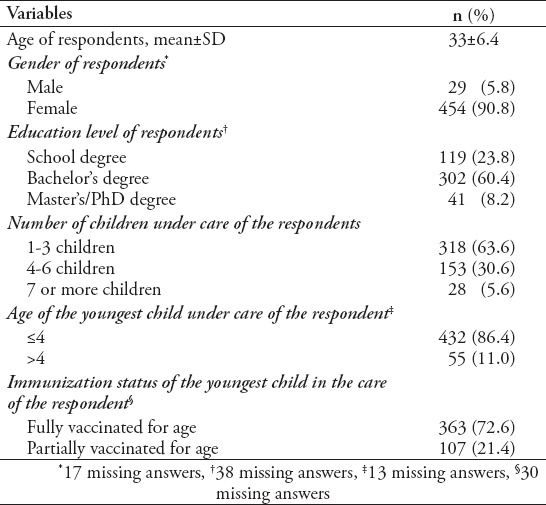
Parents’ vaccine hesitancy according to the vaccination status of the child
Overall, 100 parents (20%) said that they have been reluctant or hesitant to get their child vaccinated, and most of those hesitated for some vaccines (n=97). Three parents reported refusing all vaccines and indicated that their children had received only the birth vaccine but none thereafter. A total of 21.4% children were stated to be partially vaccinated for age.
Among parents who reported hesitancy toward vaccination, 36% of children were not vaccinated fully for their age, in comparison with only 18% of children not fully vaccinated for age in the nonhesitant parents group (Chi-square test <0.001).
Table 2 presents the influence of demographics on vaccine hesitancy and vaccination status. Interestingly, male gender and parents with a postgraduate degree namely, master’s degree or PhD tended to be more vaccine hesitant compared with parents who had a bachelor’s degree or school degree (p<0.001).
Table 2.
Influence of demographics on hesitancy and vaccination status.
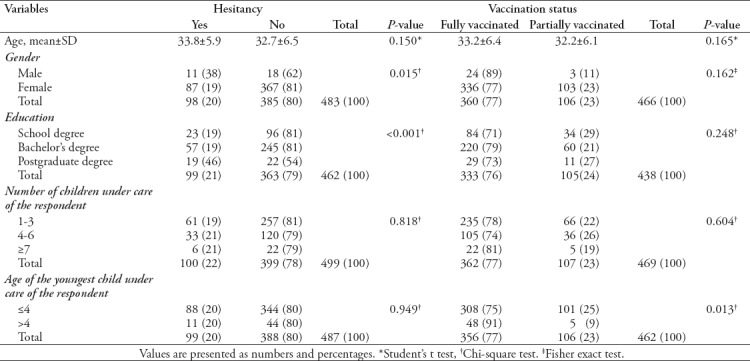
In addition, parents who had a child aged 4 years or younger were more likely to report partial vaccination status (p<0.013) compared with parents who had older children.
Table 3 illustrates the levels of hesitancy of parents toward specific types of vaccines. Fifty-eight parents reported hesitancy toward the influenza vaccine, followed by MMR (n=49) and DTaP (n=23).
Table 3.
Hesitancy and refusal according to type of vaccine.
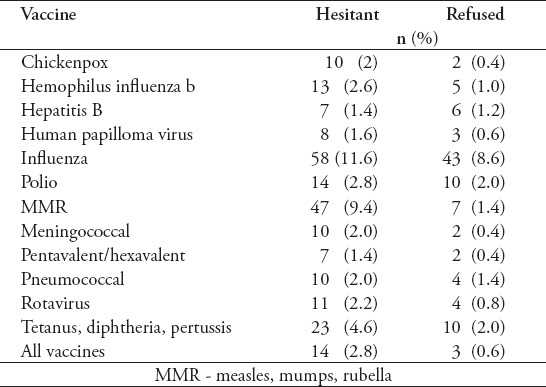
Table 4 shows the vaccination status of the youngest child according to parents’ attitude toward vaccination. The proportions of parents with partially vaccinated children who agreed that vaccines are important for health of children, who believed that vaccines are effective, who believed that vaccination of their children is important for the health of others in the community, and who trusted vaccine-related information provided by the government were lower than the proportions of agreement in parents of children who were fully vaccinated (p<0.001).
Table 4.
Vaccination status according to parent's attitude towards vaccination.
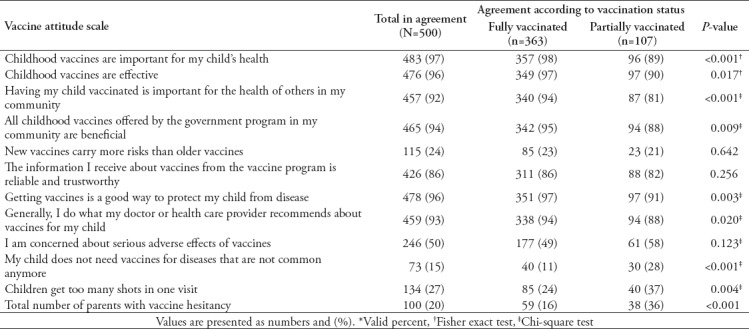
Parents of partially vaccinated children were more likely to think that their children did not need vaccines for diseases that are no longer common and to believe that their children were getting too many shots in one visit. Parents of fully vaccinated children were significantly more likely to follow the vaccine recommendations offered by their physicians and to believe that getting vaccines is a good way to protect from diseases (p<0.003).
In examining specific reasons for hesitancy among the 100 VHPs, their responses were recorded in the open-ended questions (Table 5). We found that concerns related to vaccine safety (n=53) were the most common reason, and relating autism with MMR was expressed by approximately half of VHPs (n=47). Fear of side effects (n=41) and mistrust in vaccine effectiveness (n=26) were the other frequent reasons mentioned.
Table 5.
Main worries and concerns reported by 100 vaccine hesitant parents when taking their child for vaccination.
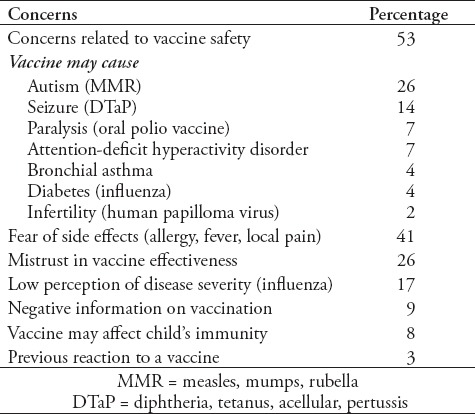
The effect of vaccine attitude on hesitancy and on partial vaccination status of last child is depicted in Table 6, where adjustments for effects of other demographic variables were made. A higher odds of hesitancy was observed among parents who believed that vaccines are ineffective (odds ratio [OR]=28), believed that childhood vaccines are not important (OR=27), and believed that vaccines are not a good way to protect their children from diseases (OR=19), where all of these findings were statistically significant (p<0.001). All remaining survey items showed statistically significant associations with hesitancy status but with smaller effect sizes.
Table 6.
Regression analyses on vaccine attitudes associated with parent's hesitancy and partial vaccination status.
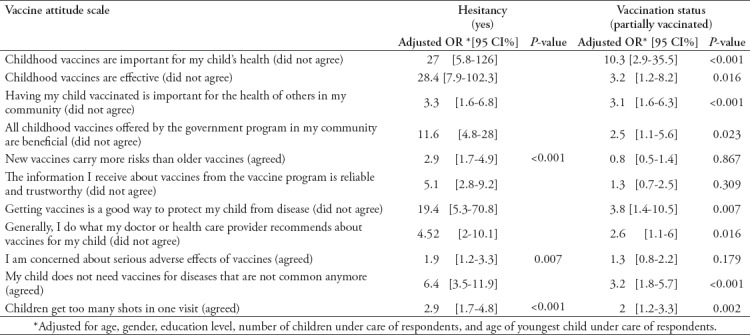
The question whether new vaccines carry more risk than older vaccine was negatively associated with having full vaccination status; however, this was not statistically significant (p=0.86).
Similarly, negative believes toward vaccination increased the odds of parents reporting partial vaccination of their children. However, it can be noted that for every survey item reported in Table 6, odds of having children partially vaccinated for age are either smaller or none statistically significant when compared to odds of hesitancy. Finally, the odds of parents reporting partial vaccination of their children was calculated according to overall presence of hesitancy and adjusting for demographic variables where the odds of having partially vaccinated children was 2.78 95% CI: [1.64-7.72], p=0.0001) among hesitant parents compared to none hesitant ones.
Discussion
Whereas previous surveys in Kingdom of Saudi Arabia have focused on knowledge of and attitudes toward vaccination, this survey, based in Riyadh, KSA, represents the investigation of parental vaccine hesitancy and its determinants.17,18 In the present study, we used the scale that was designed by the SAGE group to measure vaccine hesitancy and its determinants in a sample of Saudi parents. Moreover, we focused on the relationship between vaccine hesitancy using the vaccine hesitancy scale and outcome of children’s immunization status (partial/complete).
We found that the prevalence of VHPs was 20%, while less than 1% of parents were fully against vaccinations. Similar studies reported different proportions of hesitant parents across countries, given that the definition of hesitancy has varied across studies and that hesitancy has been demonstrated to be country and time specific.9,19 For example, about one-third of parents in the United States of America are considered to be vaccine hesitant.2,20
As a result of the retrospective design of the study, not all parents remembered their attitudes during the time of the vaccination visit. Parents who agree to get their child vaccinated can still have significant concerns and are regarded as vaccine hesitant.21,22 Those parents should be targeted because of their risk of stopping vaccines, since they are typically receptive to information about vaccination from trusted health care providers as compared with those who are absolutely against vaccines.23 A recent report suggested that children whose parents are hesitant or who have concerns about vaccines can obtain vaccination coverage that is comparable to children whose parents have no vaccine safety concerns, as long as the parents’ decision to get their child immunized is influenced by a trusted health care provider, especially their physician.11
It is noteworthy that our reported rate of complete immunization status of 73% is much lower than that in a previous report from Kingdom of Saudi Arabia (86%).17,18 We demonstrated the positive beliefs of VHP toward specific aspects of vaccines. However, these positive perceptions were mitigated by concerns about the safety of vaccinations, fear of side effects, and mistrust of vaccine effectiveness. Almost half of VHPs have some concerns related to vaccine safety, confirming other findings reported in previous surveys conducted in Canada and Australia. According to these surveys, 40-52% of parents stated that they had concerns when vaccinating their child.24,25 However, these results contradict the low reported rate of concerns on vaccine safety from KSA and other Eastern Mediterranean region countries of 2-5%.17,18
The expressed high rate of parental concerns about vaccine safety is not strange, considering the number of vaccine shots required and the successful control of many VPDs, which has made them considerably less apparent. In view of the high proportion of VHPs who have had their children fully immunized, reporting at least one concern does not mark an overall lack of trust. In reality, parents’ queries should be anticipated and used as a chance to sustain and build up their understanding and acceptance of vaccines. Despite that many studies have disproved any increased risk of developing autism after vaccination, almost half of VHPs in our study still believe the link between vaccines and autism.26,27 Concerns related to vaccines are not only limited to parents; earlier qualitative interviews reported that health care providers, while holding an overall positive belief toward vaccines, have also expressed uncertainties about new vaccines, in addition to mistrust of vaccine schedules and pharmaceutical companies.28 The positive influence of health care professionals’ recommendations on parental vaccine confidence is well recognized.29,30 Therefore, controlling the dissemination of vaccine hesitancy will depend on the education of health professionals to provide an univocal message to parents. Moreover, studies have shown that messaging that too strongly endorses vaccination among those who are hesitant may backfire in enhancing hesitancy rather than lessening it.31
In our sample, vaccine hesitancy among VHPs was related to some vaccines, mostly influenza, MMR, and DTaP vaccines. Parents may perceive some of these vaccines as being against mild diseases (namely, influenza) when compared with vaccines targeting more serious diseases.32 Previous reports have also demonstrated that new vaccines, for example, rotavirus and the human papillomavirus vaccines, are further prone to vaccine hesitancy. In one study, half of the surveyed parents expressed doubts that new vaccines are safe compared with older vaccines, despite the fact that most of these parents indicated that their child was fully immunized.33
In our population, the attitude toward vaccination is associated with hesitancy level, as shown in the regression analysis. However, negative beliefs toward vaccination seem to increase hesitancy. Nonetheless, negative attitudes seem to have a smaller association with the actual practice, as demonstrated by the vaccination status of the last child. For example, among parents who believe that vaccination is not important for the health of their children, the odds of hesitancy is 27. Yet, in the same category of parents who believe vaccination of their children is not important for their health, the odds of having their last child fully vaccinated is 10. This means that attitudes among parents in our sample had a smaller influence on practice (actual vaccination), this is similar to what was reported by Dubé et al.34 This can be explained simply by the fact that vaccination regulations in KSA are less liberal compared with Western countries. Despite what parents believe about vaccine hesitancy, not receiving vaccination will eventually hinder provision of services (mainly schooling for children). This was clearly apparent by the finding that the most frequently refused vaccine was influenza, since it is an optional seasonal vaccine for most community members. Also, the intention to protect their child from VPD is reassuring to note.
Our analysis has also identified factors associated with vaccine hesitancy. The strongest factors associated with parents’ vaccine hesitancy and vaccination status were parents’ perception of vaccines being ineffective and that vaccines are not important for child health. Similarly, not considering that vaccines are effective for protection from diseases was also a factor associated with vaccine hesitancy. Another factor associated with vaccine hesitancy was not believing that vaccines offered by the government are beneficial. These factors were also recognized in previous studies as determinants of vaccination decision.35 This finding focuses on important barriers when addressing vaccine hesitancy. Previous reports have highlighted that public hesitancy toward vaccines was not due to lack of information but somewhat due to multiple levels of mistrust of physicians, health authorities, and pharmaceutical companies.36
We compared our results to recently published reports that used the vaccine hesitancy scale to evaluate differences among demographic groups.37,38 In accordance with the Canadian study, our findings showed that fathers are more hesitant toward vaccines.37 However, in contrast to the Canadian and Chinese studies, we found that parents who had higher education had greater vaccine hesitancy.38 Globally, there is a growing concern that more highly educated parents are more concerned about and more skeptical toward vaccination than populations with lower education levels and are therefore more likely to seek exemptions.39 However, this is not a uniform pattern, one systematic review that included studies from low and middle income countries indicated that maternal education level directly influenced the acceptance of and attitudes toward vaccines.40 Thus, health care providers will be more efficient if they tailor the vaccines information needs to individuals’ educational levels.
Families who had a child aged 4 years or younger were more likely to report incomplete vaccination status. However, most of those families were not vaccine hesitant. It is worth noting that part of the study was conducted during a temporary national shortage of the 18-month first booster of pentavalent vaccine (Pentacel: DTaP-IPV/Hib). This might have affected the results in this age group.
Study limitations
As KSA has no central immunization registry and the vaccination status of the child was stated as reported by parents, this might be possibly under or overestimated because of social desirability or recall bias. We did not consistently ask to refer to the vaccination card during our parent interview. Our study population predominantly included mothers, as most children were accompanied by their mothers during the clinic visits. The geographical distribution of our sample included residents from the Riyadh area, which may have introduced bias in our estimates because of the possible association between area of residence and hesitancy.
Although this study was not intended to validate the vaccine hesitancy scale, we observed that 3 items on the Likert scale (L5, L10, and L11) were constructed in the reverse direction from other questions. The surveyors noted that parents needed clarification for these items during the interview. To counter this matter and reduce bias, we suggest that the direction of questions be randomized and, if applicable, these items reversed.
In conclusion, our findings indicate that vaccine hesitancy is a major concern among parents in KSA, suggesting a risk to the currently reported high vaccination level. Vaccination status of children cannot be used as the main indicator to assess vaccine hesitancy, as it does not consider parents who have significant concerns toward vaccines. Countering concerns related to vaccines, particularly in higher educated groups, is important. It is important to tailor the information provided to each parent’s needs. There is a need to detect and follow up the trends of vaccine hesitancy in Saudi populations over time. A future longitudinal study based on region could examine how attitudes toward vaccines evolve in our population as parents are exposed to more negative information from the media. Health care workers involved in providing vaccines should be effectively trained to improve their counseling and communication skills.
Footnotes
References
- 1.Larson HJ, Cooper LZ, Eskola J, Katz SL, Ratzan S. Addressing the vaccine confidence gap. Lancet. 2011;378:526–535. doi: 10.1016/S0140-6736(11)60678-8. [DOI] [PubMed] [Google Scholar]
- 2.Siddiqui M, Salmon DA, Omer SB. Epidemiology of vaccine hesitancy in the United States. Hum Vaccin Immunother. 2013;9:2643–2648. doi: 10.4161/hv.27243. [DOI] [PMC free article] [PubMed] [Google Scholar]
- 3.Gellin BG, Maibach EW, Marcuse EK. Do parents understand immunizations?A national telephone survey. Pediatrics. 2000;106:1097–1102. doi: 10.1542/peds.106.5.1097. [DOI] [PubMed] [Google Scholar]
- 4.Offit P. Vaccines and autism revisited:the Hannah Poling case. N Engl J Med. 2008;358:2089–2091. doi: 10.1056/NEJMp0802904. [DOI] [PubMed] [Google Scholar]
- 5.Chatterjee A, O'Keefe C. Current controversies in the USA regarding vaccine safety. Expert Rev Vaccines. 2010;9:497–502. doi: 10.1586/erv.10.36. [DOI] [PubMed] [Google Scholar]
- 6.Offit PA, Quarles J, Gerber MA, Hackett CJ, Marcuse EK, Kollman TR, et al. Addressing parents'concerns:do multiple vaccines overwhelm or weaken the immune system? Pediatrics. 2002;109:124–129. doi: 10.1542/peds.109.1.124. [DOI] [PubMed] [Google Scholar]
- 7.Cherry JD. Epidemic pertussis in 2012 - the resurgence of a vaccine-preventable disease. N Engl J Med. 2012;367:785–787. doi: 10.1056/NEJMp1209051. [DOI] [PubMed] [Google Scholar]
- 8.Centers for Disease Control and Prevention (CDC). Measles - United States, 2011. MMWR Morb MortalWkly Rep. 2012;61:253–257. [PubMed] [Google Scholar]
- 9.DubéE Gagnon D, Nickels E, Jeram S, Schuster M. Mapping vaccine hesitancy:Country-specific characteristics of a global phenomenon. Vaccine. 2014;32:6649–6654. doi: 10.1016/j.vaccine.2014.09.039. [DOI] [PMC free article] [PubMed] [Google Scholar]
- 10.The Strategic Advisory Group of Experts (SAGE) Report of the SAGE working group on vaccine hesitancy [Internet] Updated 2014. Cited 2018 June 14. Available form: http://www.who.int/immunization/sage/meetings/2014/october/SAGE_working_group_revised_report_vaccine_hesitancy.pdf .
- 11.Smith PJ, Kennedy AM, Wooten K, Gust DA, Pickering LK. Association between health care providers'influence on parents who have concerns about vaccine safety and vaccination coverage. Pediatrics. 2006;118:1287–1292. doi: 10.1542/peds.2006-0923. [DOI] [PubMed] [Google Scholar]
- 12.Larson HJ, Jarrett C, Schulz WS, Chaudhuri M, Zhou Y, Dube E, et al. Measuring vaccine hesitancy:the development of a survey tool. Vaccine. 2015;33:4165–4175. doi: 10.1016/j.vaccine.2015.04.037. [DOI] [PubMed] [Google Scholar]
- 13.Al-Shehri SN, Al-Shammari SA, Khoja TA. Missed opportunities for immunization. Can Fam Physician. 1992;38:1087–1091. [PMC free article] [PubMed] [Google Scholar]
- 14.Ministry of Health. EPI increased to more than 95% in the Kingdom. Updated 2019. Cited 2012 March 12. Available from: http://www.moh.gov.sa/en/Ministry/MediaCenter/News/Pages/NEWS-2011-5-3-001.aspx .
- 15.Ministry of Heath. Annual statistical year book 2017. Cited 2019 June 10. Available from: https://www.moh.gov.sa/en/Ministry/Statistics/book/Documents/ANNUAL-STATISTICAL-BOOK-1438H.pdf .
- 16.Orenstein WA, Hinman AR. The immunization system in the United States-the role of school immunization laws. Vaccine. 1999;17:S19–24. doi: 10.1016/s0264-410x(99)00290-x. [DOI] [PubMed] [Google Scholar]
- 17.Alshammari T, Subaiea G, Talib H, Moin A, Kazeem Y. Parental perceptions, attitudes and acceptance of childhood immunization in Saudi Arabia:A cross sectional study. Vaccine. 2018;36:23–28. doi: 10.1016/j.vaccine.2017.11.050. [DOI] [PubMed] [Google Scholar]
- 18.Yousif MA, Albarraq AA, Abdallah MAA, Elbur AI. Parents'Knowledge and attitudes on childhood immunization, Taif Saudi Arabia. J Vaccines Vaccin. 2013;5:215. [Google Scholar]
- 19.MacDonald NE. The SAGE working Group on Vaccine Hesitancy. Vaccine hesitancy: definition, scope and determinants. Vaccine. 2015;33:4161–4164. doi: 10.1016/j.vaccine.2015.04.036. [DOI] [PubMed] [Google Scholar]
- 20.Opel DJ, Taylor JA, Zhou C, Catz S, Myaing M, Mangione-Smith R. The relationship between parent attitudes about childhood vaccines survey scores and future child immunization status:a validation study. JAMA Pediatr. 2013;167:1065–1071. doi: 10.1001/jamapediatrics.2013.2483. [DOI] [PMC free article] [PubMed] [Google Scholar]
- 21.World Health Organization (WHO). Eastern Mediterranean region. Framework for health information systems and core indicators for monitoring health situation and health system performance 2015. Updated 2016. Cited 2019 June 11. http://applications.emro.who.int/dsaf/EMROPUB_2015_EN_1904.pdf?ua=1 .
- 22.Gust DA, Darling N, Kennedy A, Schwartz B. Parents with doubts about vaccines:which vaccines and reasons why. Pediatrics. 2008;122:718–725. doi: 10.1542/peds.2007-0538. [DOI] [PubMed] [Google Scholar]
- 23.Leask J. Target the fence-sitters. Nature. 2011;473:443–445. doi: 10.1038/473443a. [DOI] [PubMed] [Google Scholar]
- 24.Dube E, Gagnon D, Ouakki M, Bettinger JA, Guay M, Halperin S, et al. Understanding vaccine hesitancy in Canada:results of a consultation study by the Canadian immunization research network. PLoS ONE. 2016;11:e0156118. doi: 10.1371/journal.pone.0156118. [DOI] [PMC free article] [PubMed] [Google Scholar]
- 25.Chow My, Danchin M, Willaby HW, Pemberton S, Leask J. Parental attitudes, beliefs, behaviours and concerns towards childhood vaccinations in Australia:a national online survey. Aust Fam Physician. 2017;46:145–151. [PubMed] [Google Scholar]
- 26.De Stefano F, Price CS, Weintraub ES. Increasing exposure to antibody stimulating proteins and polysaccharides in vaccines is not associated with risk of autism. J Pediatr. 2013;163:561–567. doi: 10.1016/j.jpeds.2013.02.001. [DOI] [PubMed] [Google Scholar]
- 27.Taylor LE, Swerdfeger AL, Eslick GD. Vaccines are not associated with autism:an evidence-based meta-analysis of case-control and cohort studies. Vaccine. 2014;32:3623–3629. doi: 10.1016/j.vaccine.2014.04.085. [DOI] [PubMed] [Google Scholar]
- 28.Manca T. “One of the greatest medical success stories:“Physicians and nurses'small stories about vaccine knowledge and anxieties. Soc Sci Med. 2018;196:182–189. doi: 10.1016/j.socscimed.2017.11.027. [DOI] [PubMed] [Google Scholar]
- 29.Hollmeyer HG, Hayden F, Poland G, Buchholz U. Influenza vaccination of health care workers in hospitals:a review of studies on attitudes and predictors. Vaccine. 2009;27:3935–3944. doi: 10.1016/j.vaccine.2009.03.056. [DOI] [PubMed] [Google Scholar]
- 30.Posfay-Barbe KM, Heininger U, Aebi C, Desgrandchamps D, Vaudaux B, Siegrist CA. How do physicians immunize their own children?Differences among pediatricians and nonpediatricians. Pediatrics. 2005;116:e623–33. doi: 10.1542/peds.2005-0885. [DOI] [PubMed] [Google Scholar]
- 31.Nyhan B, Reifler J, Richey S, et al. Effective messages in vaccine promotion:a randomized trial. Pediatrics. 2014;133:e835–e842. doi: 10.1542/peds.2013-2365. [DOI] [PubMed] [Google Scholar]
- 32.MacDonald NE, Smith J, Appleton M. Risk perception, risk management and safety assessment:what can governments do to increase public confidence in their vaccine system? Biologicals. 2012;40:384–388. doi: 10.1016/j.biologicals.2011.08.001. [DOI] [PubMed] [Google Scholar]
- 33.Ekos Research Associates Inc. Survey of parents on key issues related to immunization. Ottawa: Public Health Agency of Canada, 2011; Cited 2019 June 11. Available from: http://resources.cpha.ca/immunize.ca/data/1792e.pdf . [Google Scholar]
- 34.DubéE Gagnon D, Zhou Z, Deceuninck G. Parental Vaccine Hesitancy in Quebec (Canada) PLoS Curr. 2016:8. doi: 10.1371/currents.outbreaks.9e239605f4d320c6ad27ce2aea5aaad2. [DOI] [PMC free article] [PubMed] [Google Scholar]
- 35.Smith LE, Amlôt R, Weinman J, Yiend J, Rubin GJ. A systematic review of factors affecting vaccine uptake in young children. Vaccine. 2017;35:6059–6069. doi: 10.1016/j.vaccine.2017.09.046. [DOI] [PubMed] [Google Scholar]
- 36.Yaqub O, Castle-Clarke S, Sevdalis N, Chataway J. Attitudes to vaccination:a critical review. Soc Sci Med. 2014;112:1–11. doi: 10.1016/j.socscimed.2014.04.018. [DOI] [PubMed] [Google Scholar]
- 37.Shapiro GK, Tatar O, Dube E, Amsel R, Knauper B, Naz A, et al. The vaccine hesitancy scale:Psychometricproperties and validation. Vaccine. 2018;36:660–667. doi: 10.1016/j.vaccine.2017.12.043. [DOI] [PubMed] [Google Scholar]
- 38.Ren J, Wagner AL, Zheng A, Sun X, Boulton ML, Huang Z, et al. The demographics of vaccine hesitancy in Shanghai, China. PLoS One. 2018;13:e0209117. doi: 10.1371/journal.pone.0209117. [DOI] [PMC free article] [PubMed] [Google Scholar]
- 39.Edwards KM, Hackell JM. The Committee on Infectious Diseases, The Committee on Practice and Ambulatory Medicine. Countering vaccine hesitancy. Pediatrics. 2016;138:e20162146. doi: 10.1542/peds.2016-2146. [DOI] [PubMed] [Google Scholar]
- 40.Phillips DE, Dieleman JL, Lim SS, Shearer J. Determinants of effective vaccine coverage in low and middle-income countries:a systematic review and interpretive synthesis. BMC Health Serv Res. 2017;17:681. doi: 10.1186/s12913-017-2626-0. [DOI] [PMC free article] [PubMed] [Google Scholar]


